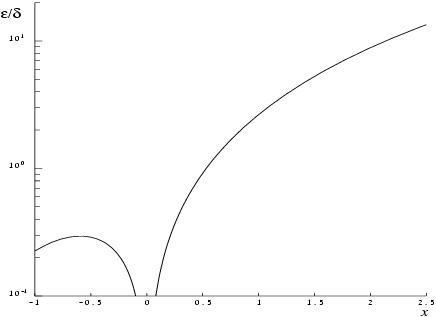s15ad returns the value of the complementary error function, .
 Syntax
Syntax
| C# |
|---|
public static double s15ad( double x ) |
| Visual Basic |
|---|
Public Shared Function s15ad ( _ x As Double _ ) As Double |
| Visual C++ |
|---|
public: static double s15ad( double x ) |
| F# |
|---|
static member s15ad : x : float -> float |
Parameters
- x
- Type: System..::..DoubleOn entry: the argument of the function.
Return Value
s15ad returns the value of the complementary error function, .
 Description
Description
s15ad calculates an approximate value for the complement of the error function
Let be the root of the equation (then ). For the value of is based on the following rational Chebyshev expansion for :
where denotes a rational function of degree in the numerator and in the denominator.
For the value of is based on a rational Chebyshev expansion for : for the value is based on the expansion
and for it is based on the expansion
For each expansion, the specific values of and are selected to be minimal such that the maximum relative error in the expansion is of the order , where is the maximum number of decimal digits that can be accurately represented for the particular implementation (see x02be).
For there is a danger of setting underflow in (the value of is given in the Users' Note for your implementation). For , s15ad returns ; for it returns .
 References
References
Abramowitz M and Stegun I A (1972) Handbook of Mathematical Functions (3rd Edition) Dover Publications
Cody W J (1969) Rational Chebyshev approximations for the error function Math.Comp. 23 631–637
 Error Indicators and Warnings
Error Indicators and Warnings
There are no failure exits from s15ad. The parameter _ifail has been included for consistency with other methods in this chapter.
 Accuracy
Accuracy
If and are relative errors in the argument and result, respectively, then in principle
That is, the relative error in the argument, , is amplified by a factor in the result.
The behaviour of this factor is shown in Figure 1.
It should be noted that near this factor behaves as and hence the accuracy is largely determined by the machine precision. Also for large negative , where the factor is , accuracy is mainly limited by machine precision. However, for large positive , the factor becomes and to an extent relative accuracy is necessarily lost. The absolute accuracy is given by
so absolute accuracy is guaranteed for all .
 Parallelism and Performance
Parallelism and Performance
None.
 Further Comments
Further Comments
None.
 Example
Example
This example reads values of the argument from a file, evaluates the function at each value of and prints the results.
Example program (C#): s15ade.cs
